-
Posts
701 -
Joined
-
Last visited
-
Days Won
1
Content Type
Profiles
Forums
Blogs
Gallery
Events
Store
Posts posted by ColinRF
-
-
The following is based on Wiki but has been added to by me.
Georg von Boeselager was born near Kassel into an aristocratic and catholic family. He initially considered becoming a priest but in the end decided to follow a military career. He joined the 15th Cavalry Regiment in 1934 and was commissioned in 1936. He took part in the invasion of Poland where he earned an Iron Cross Second Class. In France, in 1940, he earned an Iron Cross First Class for gallantry in establishing a bridgehead over the Seine. In the following January, he was awarded the Knight's Cross.. His July 1941 fitness report described him as "...a spirited cavalry officer, who thinks boldly and surely in taking decisions, but who is modest and unassuming, the idol of his men."
In the Invasion of Russia, Boeselager again made a name for himself as his unit performed reconnaissance for the double-pronged sweep around Brest-Litovsk to take Bialystok and Minsk, seized bridgeheads over the Nieman and Daugava rivers, and participated in the Battle for Moscow. For these actions he was awarded the oak leaves to his Knight's Cross. At this point in his career he was made Instructor of Tactics at the "School for Shock troops" in Krampintz where he instructed students in panzer tactics. However, Boeselager preferred commanding traditional horsed cavalry, which he felt still had a place on the modern battlefield. While an instructor at the school, Boeselager became acquainted with members of the military resistance.
Boeselager next was assigned to train troops of the Rumanian III Army fighting on the flank of 6. Armee at Stalingrad. After an audience with Generalfeldmarschall von Kluge, commander of Army Group Centre, Boeselager was assigned to command Cavalry Regiment Centre, a freestanding cavalry force consisting of elite German horse troops and Russian cossacks. Boeselager made frequent trips to confer with Kluge, sometimes flying along with the field marshal's staff on his transport plane.
At a 1943 field conference, the feasibility of assassinating Hitler was discussed among some of the officers present. It was proposed to kill Hitler with a pistol, but no officer could be found willing to attempt it. Even von Boeselager, an expert marksman, was not sure that he possessed the necessary sang froid to draw and shoot Hitler in the head. Boeselager confided to his new friend and future superior, Colonel von Tresckow, that he would likely freeze up as well. It was the method, not the fact of the killing itself, that bothered Boeselager. In fact, he had come to believe that he had a duty to God and his fellow men to eliminate Hitler, who was the antithesis of all that his religious upbringing represented. Instead of a lone assassination, Boeselager envisioned a scenario where, in command of a cavalry honour guard, he would overwhelm Hitler's SS bodyguard and kill the F?hrer. On Hitler?s visit to Smolensk, the plan was put in action but Hitler changed his route and the ambushing forces did not make contact.
In June 1943, Boeselager was promoted Major and in December to Lt. Colonel. In June 1944, Boeselager was dispatched by Tresckow to urge his old commander, Kluge to discuss tactics and to try to get Tresckow transferred to the Western Front to Kluge's staff. As Tresckow envisioned it, Kluge would arrange for his transfer so that he could help consolidate the coup. However, Kluge felt the Americans and British soon would be "opening up" his front no matter what he actions he took and he did not trust most of his staff to keep silent about the conspiracy. He therefore declined to participate in the plot or any planning. Boeselager returned to Tresckow empty-handed, but he still had a contribution to make.
In support of the July plot, Boeselager was waiting with his brother Phillip and the greater part of his cavalry brigade to move to the rear and to be flown into Berlin to assist with post-coup consolidation. Although the entire unit made a march of many hundreds of miles to the rear to position for their flight to Berlin, the failure of the bomb plot led to an abort being called and a return to the front. While almost everyone in the unit was aware of the reason for the movement, n one reported the officers who ordered it.
Boeselager also helped Wessel von Freytag-Loringhoven in procuring the British hexegen plastic explosive and other parts used in the bomb meant to kill Hitler (a fact that his friends who were tortured by Hitler's security services never revealed).
Although the Boeselager brothers escaped initial suspicion, investigators sent a message to one of Georg's old units in France requesting that "First Lieutenant von Boeselager" be detained for questioning. His former comrades replied (semi-truthfully, since Boeselager had long since been promoted) that they knew no such officer. Even though he was now a field-grade officer, Georg continued his hard-charging cavalryman's ways. Aware his life was in danger, he may have wished to die a hero, reasoning that his family would be less liable to Nazi persecution. Alternately, he may have been despondent over the failure of the plot and the future of Germany under probable Soviet occupation. Boeselager carried his motivation to the grave. He fell leading an assault against a heavily fortified Soviet position near the River Bug on August 27, 1944. Two days later, he was posthumously promoted to full colonel and awarded the Knight's Cross with Oak Leaves and Swords, one of only 159 German soldiers so decorated in the history of the award. If one discounts the senior officers decorated for the actions of their troops and the airmen decorated for single accomplishment, von Boeleslager was among only twenty or so Heer officers of below general officer rank so decorated.
The Bundeswehr's Freiherr von Boeselager Kaserne ("Baron von Boeselager Barracks") in Munster is named for him, as are Georg-von-Boeselager-Strasse ("George von Boeselager Street") and Georg-von-Boeselager-Schule ("George von Boeselager Primary School") in Swisttal. For many years, the Bundeswehr conducted an annual (then a semi-annual) armoured reconnaissance competition composed of 7 events open to all NATO nations. The competition was called the "Boeselager Cup". It was cancelled in 1998 as pressure from operational commitments on the NATO countries restricted their ability to participate.
The picture of Georg bestowing the Knight's Cross on an officer is of interest - its his brother Phillip. Surprisingly not the only sibling Knight's Cross recipients.
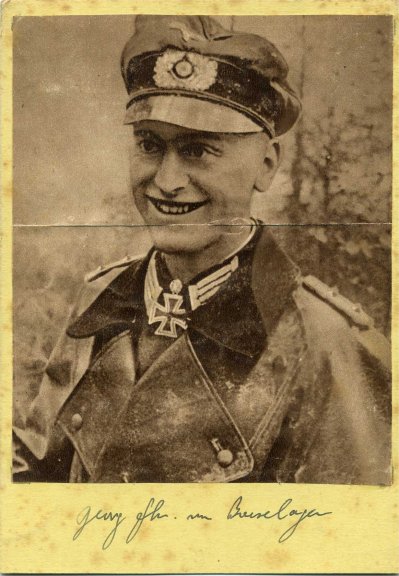
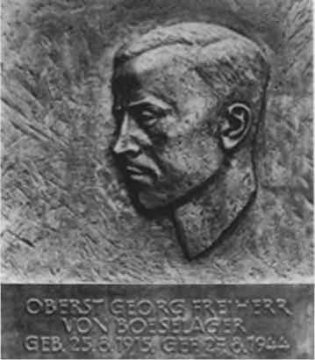
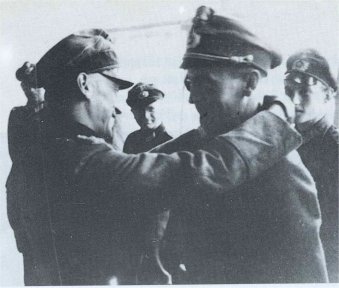 0
0 -
Rudolph-Christoph Freiherr von Gersdorff was the officer who arguably managed to come second closest, after Stauffenberg, to personally assassinating Hitler.
Von Gersdorff grew up in a military family. His father was a Generalmajor and von Gersdorff began his career in 1923 with the family regiment, the 1. Schlesisches Leibkuerassier Regiment or"Grosser Kurfuerst," later Reiter Regiment 7. He was a Rittmeister when he entered the Prussian Military Academy and joined the General Staff in 1938. He served in Poland and France as a staff officer and, prior to the attack on Russia, von Gersdorff was assigned to Heeresgruppe Mitte as 1c (Senior Staff Officer - Intelligence), where he served with his cousin Oberleutnant Fabian von Schlabrendorff.
On March 13, 1943, Oberst Henning von Tresckow and his ADC Oberleutnant von Schlabrendorff carried out their assassination attempt on Hitler by secreting a bomb on his plane disguised as a wrapped gift of liqueur. It failed to detonate and Hitler landed safely. Following this failure, Oberst Von Gersdorff volunteered to kill Hitler should the opportunity arise. The perfect chance presented itself eight days later when, on March 21, 1943, the annual "Heroes Memorial Day" was scheduled. Hitler was due to give a speech and then tour an exhibit of captured Russian war materiel at the baroque Zeughaus on the Unter Den Linden. The exhibition was put on by Heeresgruppe Mitte and, von Gersdorff, in his capacity as 1c of the Heeresgruppe, was quickly recruited to guide Hitler and his senior commanders through the exhibit. This was recognized as a one in a lifetime opportunity to remove the "head of the snake" at one stroke as Hitler, G?ring, Himmler, Doenitz, Keitel and Jodl could all be expected to be present in physical proximity to each other in a relatively confined indoor space. As a result, von Gersdorff opted for a mobile suicide bomb attack as he recognized that his only option was to make the attack as the Fuehrer and his escort worked their way through the exhibit. Von Gersdorff's wife died in early 1943 and this was a significant factor in motivating him to make this attempt..
Following Hitler's speech, von Gersdorff activated two 10-minute British acid time fuses in two bombs carried in his overcoat pockets. He did his best to interest Hitler in the various items and photographs on display and to stay as close as possible to ensure that Hitler and his senior commanders all died as the bombs exploded. Contrary to his behavior in prior years, Hitler literally bolted through the exhibit, showed little or no interest in the display. Possibly as a result of his famous sixth sense for danger, he veered from his programmed course and exited via a side door so quickly that he caught the announcer and awaiting review guard unprepared. Von Gersdorff was left to quickly and quietly find his way to a public toilet where he managed to pull the fuses and disarm the bombs prior to detonation. This was one of Hitler's last public appearances of the war and represented a last chance for the conspirators.
In April 1943, soon after the failure of his Zeughaus attempt, von Gersdorff was once again a witness to history when he was one of the officers who discovered the buried evidence of Stalin's 1940 massacre of over 4,000 Polish officer POWs at Katyn in Poland. Later in 1944, he was involved indirectly in the July Plot when he acted as custodian of the resisters' explosives before passing them via Wessel von Freytag-Loringhoven to Claus von Stauffenberg.
On August 26, 1944, Oberst i.G. von Gersdorff, who had already been awarded the Iron Cross first class, was awarded the Knight's Cross to the Iron Cross for his services in extracting a significant portion of 7. Armee from the Falaise Gap. He finished the war as a Generalmajor and was captured by the Americans in 1945. He attempted to continue his military career by joining the newly formed Bundeswehr in 1947 but he was obstructed by government officials and soldiers who did not want to serve with a "traitor."
After the war, von Gersdorff founded the German arm of St. John?s Ambulance before becoming paralyzed in a riding accident and dying in Munich in 1980. In 1981, he was posthumously honoured when the former Belgian "Loncin-Kaserne" in Euskirchen was renamed after him by the Bundeswehr.
Seen below is the title page from his autobiography "Soldat im Untergang," signed from Munich by Rudolph-Christoph Freiherr von Gersdorff and dated less than a year before his death. In one of my collecting coups, I picked this first edition signed memoir up on ebay for 5 pounds! I also include a shot of the Zeughaus that I took in 2006.
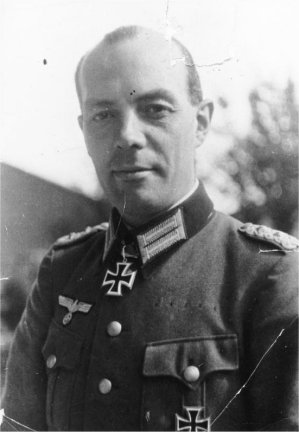
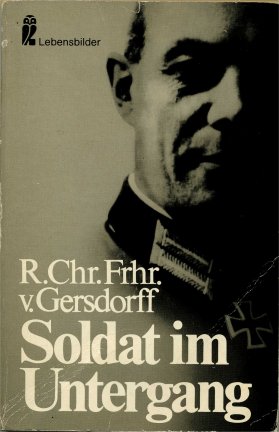
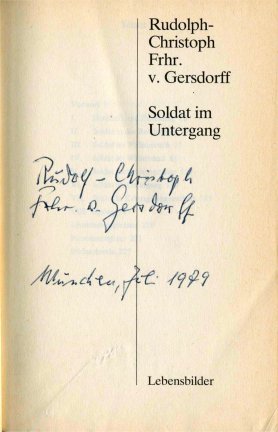
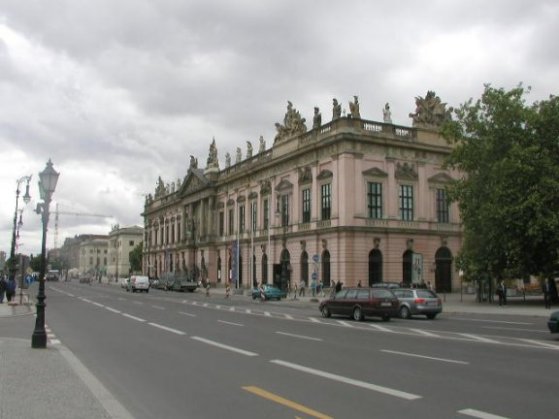 0
0 -
Fabian von Schlabrendorff was a cousin of Henning von Tresckow. He also served as Tresckow's ADC during his time in Russia. Schlabrendorff was one of the many resisters that Tresckow recruited to fill his command staff when he was Chief of Staff at Army Group Centre, and later when he was chief of Staff of 2. Armee.
Schlabrendorff was trained as a lawyer. He was also a reserve officer with the modest rank of Leutnant. Schlabrendorff was Tresckow's messenger and liaison between the far-off army group command in the East and other hubs of resistance located in the Abawehr HQ and reserve army in Berlin. In this role he maintained contact between Tresckow and other senior resisters life Goerdeler, Oster, Beck and Olbricht. His visits to Berlin to pass along plans and to discuss options are mentioned in the contemporary diary of Ulrich von Hassel.
In late 1942, Tresckow and Olbricht finalised a plan to assassinate Hitler and stage a coup. On 13 March 1943, returning from his easternmost headquarters FHQ Wehrwolf near Vinnitsa to Wolfschanze in East Prussia, Hitler was scheduled to make a stop-over at the headquarters of Army Group Centre near Smolensk. Tresckow could not pass such a rare opportunity by given the rarity of Hitler's personal appearances in the field. Several assassination plans were floated and even discussed with Generalfeldmarschall von Kluge. Only one that was implemented and it was undertaken by Tresckow and Schlabrendorff.
Tresckow's attempt to kill Hitler by smuggling a time bomb onto his aircraft has recently been dramatised quite accurately in the recent Tom Cruise film "Valkyrie." The difficulty involved getting a bomb onto Hitler's plane which was always well guarded while on the ground. Hitler flew with a retinue of several aircraft so the challenge also involved getting the bomb onto the correct plane. Tresckow asked Lieutenant Colonel Heinz Brandt, a member of Hitler's staff who usually traveled on the same plane as Hitler, to take a parcel with him. He was told that the parcel contained two bottles of Cointreau, supposedly the price of a bet won by Tresckow's friend Colonel Stieff. Like Brandt, Stieff was favourably disposed toward the resistance but he was not yet a full member. The package was a cleverly disguised bomb consisting of two British clam mines with acid time pencil fuse. Schlabrendorff set the fuse and handed over the parcel to Brandt who boarded the same plane as Hitler.
It was expected that Hitler's Focke-Wulf 200 Condor should explode about 30 minutes later over the Minsk area, close enough to the front to be attributed to Soviet fighters. Olbricht was to use the resulting crisis to mobilise his Reserve Army network to seize power in Berlin, Vienna, Munich and in the other German Wehrkries, very similar to the Valkyrie plan used on July 20, 1944. It is unclear whether Olbricht had the means at his disposal at this date to actually seize power, even with Hitler death.
But Hitler didn't die. The bomb didn't go off. When no word came of a crash, Tresckow called Wolfschanze on a pretext and found that Hitler had landed. Now they had to retrieve the bomb, which could conceivably go off at any time, without drawing suspicion. First they had to head off delivery of the package to Stieff. Tresckow called Brandt and told him that the wrong package had been delivered and to please hold it. Schlabrendorff had the unenviable job of being sent to Wolfschanze the next day to retrieve the bomb. He did so, providing Brandt with replacement liqueur. He must have sweat a lot smuggling a time bomb out of Fuehrer headquarters. As soon as he was safely on board his train, he closed the compartment door and disassembled the bomb, praying it would not go off. When he examined the pencil fuse, he found that it had fired but the plastic explosive in the clam had not ignited, an unbelievable stroke of bad luck and one source of the great "what if's" in history. It is thought that the cabin temperature was too cold to allow ignition but the exact technical cause of the failure is unknown.
Later, Schlabrendorff was involved in providing the explosive for von Gersdorff's suicide attempt on Hitler on Heroes Memorial Day on March 21.
Arrested after Tresckow's suicide, Schlabrendorrf was brutally tortured, to the extent that he suffered a heart attack in prison. He would almost certainty have been executed but his trial was pre-empted by an air raid and the loathsome Freisler was killed by a U.S. bomber. Schlabrendorff's file was lost in the ruins. When brought to trial later, Schlabrendorff used his leagl training to his advantage. He argued that he had been tortured and that torture was illegal. Strangely, the court agreed and Schlabrendorff was freed. He walked out of court only to be arrested by the Gestapo and placed in "protective custody." Schlabrendorff joined the group of high profile prisoners that included Halder and von Falkenhausen who were taken down to Italy and who were scheduled to be shot by SS guards if liberation looked likely. There he was liberated by German and then U.S. troops.
After the war, he worked as a lawyer after 1945 and became a judge at the Bundesverfassungsgericht (1967-75). He was one of the few survivors of the inner circle of conspirators and he wrote an invaluable memoir, "The Secret War Against Hitler."
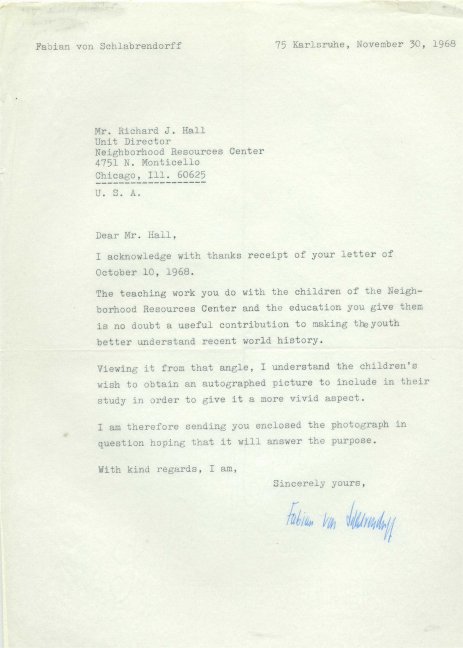
 0
0 -
Excellent work Colin.
Keep it up.
All the best
Ian
Thanks Ian. Means a lot coming from you. Nice to see you here.
Colin
0 -
reverse signed by Tresckow
 0
0 -
Fitness evaluation for Oberst i.G. Hermann Wagner from March 1944 signed by XX Korps Commander General der Artillerie v. Roman, 2. Armee Commander Generaloberst Weiss, and Oberst i.G. Henning v. Tresckow (in his capacity as 2. Armee Chief of Staff). Wagner was peripherally related to the resistance.
Interestingly, I corresponded with Hermann Wagner's grandson on another site and found the following:
Wagner's wife and the wife of General Oberst Beck had a deep friendship. Beck was to have been godfather to Wagner's son but he was executed a few weeks before he was born. Wagner also travelled to visit Rommel in Africa. Officially he said because he had troubles with his wife, but it's said that he was sent to check Rommel's point of view. After July 20, he went to jail for a few days. Family legend says that after this the regime delegated an SS officer to oversee his work. Once he had to invent a pretext, which authorised him to arrest the SS officer to have freedom of action.
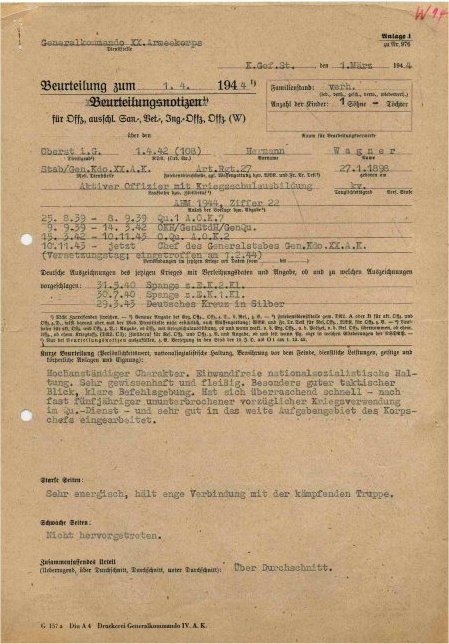 0
0 -
Turning to the Eastern Front and Tresckow's resistance cell within the staff of Army Group Centre:
"The assassination must be attempted at all costs. Even if it should not succeed, an attempt to seize power in Berlin must be made. What matters now is no longer the practical purpose of the coup, but to prove to the world and for the records of history that the men of the resistance dared to take the decisive step. Compared to this objective, nothing else is of consequence."
Henning von Tresckow was the primary mover of the German resistance movement for the period 1943 and 1944. Through his direct involvement in multiple assassination attempts and coup plans, Tresckow showed himself to be Hitler's most indefatigable enemy. Had he managed to secure access to Hitler, there can be no doubt that he would have carried out the attack with his own hands without second thought.
Tresckow grew up in a noble Prussian family with a long tradition of military service. He fought in WWI as one of the youngest soldiers carrying the rank of Leutnant and at the Second Battle of the Marne, he earned the Iron Cross. At that time, his commander in his 1. Guards Infantry Regiment, Count Siegfried von Eulenberg, presciently said: "You, Tresckow, will either become chief of the General Staff or die on the scaffold." In 1920, Tresckow left the army to study law and to run his family's estate in the Neumark region. He rejoined the Reichswehr two years later. In the inter-war period, he served in the 9th Potsdam Regiment, a unit that Axel von dem Bussche justifiably claimed saw more officers executed for treason against Hitler than any other. In 1936, he attended the Kriegsakademie where he graduated top of his class. Subsequently, he was appointed to the army's prestigious General Staff.
Like many other members of the old nobility and officers of the army, Tresckow initially found some aspects of the National Socialist agenda to be somewhat attractive; particularly their plans for rearmament and repudiation of the hated Treaty of Versailles. The 'Night of the Long Knives' in 1934 sewed some initial doubts, while Kristallnacht and the Blomberg-Fritsch Affair completely alienated him by the end of 1938. Prior to the commencement of the war, Tresckow was heavily involved in scenario analysis and war planning. It was then that he concluded that Hitler's aggressive plans would plunge Germany into an unwinnable cataclysm, particularly in the East.
In 1939, Tresckow served in the Polish campaign on the staff of 228. Infanterie Division. In 1940, he was on the staff of Heeresgruppe A during the campaign in France. At the Compiegne surrender ceremony, Oberstleutnant von Tresckow appears in newsreel footage escorting the French delegation from the famous railroad car where the surrender was signed. For the 1941 Russian Campaign, Tresckow was assigned as Chief of Staff to Heeresgruppe Mitte (Army Group Centre or AGC), then under the command of his uncle GFM Fedor von Bock.
It was here in Central Russia that Tresckow went down in history as the most ardent of those who sought Hitler's removal from power. As AGC Chief of Staff, he was very well informed of the war crimes committed by Einstazgruppe B, then under the command of another conspirator, Artur Nebe. Tresckow also had occasion to see the infamous 'Commissar Order' that required all captured Russian political officers to be executed without trial, even if taken in uniform. In his role as AGC Chief of Staff, Tresckow provided the linkage between the military and civilian elements of the resistance that were respectively personified by Ludwig Beck and Carl Goerdeler. He was heard to state that it was necessary to "shoot Hitler like a mad dog."
Tresckow was promoted to Oberst i.G. in 1942. He filled his staff almost entirely with anti-Hitler officers. These included his nephew Fabian von Schlabrendorff, Rudolf von Gersdorff, the two von Boeselager brothers, Bernd von Kleist, Hans-Alexander von Voss, Georg Schulze-Boettger, Hans-Ulrich von Oertzen, and several other senior officers. During his tenure at AGC, Tresckow actively lobbied the various Field Marshals to resist Hitler and to agree to join in the various coup attempts. Despite openly voicing his anti-Hitler views to GFMs von Bock, von Kluge, von Manstein and von Rundstedt, he got no support. On the bright side, none reported his clearly treacherous activities to the authorities and most signalled a willingness to support a new government after a successful coup.
Tresckow planned several failed assassination plots against Hitler. In March 1943, Tresckow had a hand in enticing Hitler to visit AGC HQ at the front. Several assassination attempts were planned but not carried out due to the risk of hitting innocent bystanders or due to Hitler's security precautions. On March 13, 1943, following a rare visit by the Fuehrer's to AGC headquarters, Tresckow and his ADC von Schlabrendorff managed to talk Oberst Heinz Brandt (who would ironically be killed by Stauffenberg's July 20, 1944 bomb) into taking two wrapped bottles of Cointreau to General Stieff at Wolfschanze. The Cointreau was a cleverly discussed plastic bomb with a British acid time fuse that had been flown into AGC headquarters for this express purpose by Abwehr chief Admiral Wilhelm Canaris. Tresckow had arranged with General Olbricht in Berlin to launch a coup upon news that Hitler's plane had exploded and crashed. Giving rise to one of the great "what ifs" in history, the detonator fired but the plastic did not ignite, possible due to cold cabin conditions. Hitler arrived safely and a panicked call was made to General Stieff (not at that time a conspirator) telling him not to open the Cointreau as the wrong item had been sent. Von Schlabrendorff was immediately dispatched to Wolfschanze to retrieve the evidence and ascertain what had gone wrong. A week later Tresckow tried again!
On March 21, on the annual 'Heroes Memorial Day' remembrance ceremony, AGC invited Hitler, G?ring and Himmler to view a display of captured Russian war materiel at the Berlin arsenal, or Zeughaus. This presented a rare and not to be missed opportunity to remove Hitler and his two most likely successors at one sweep. Oberst von Gersdorff, AGC's counterintelligence officer, volunteered to carry plastic explosive in his uniform pockets and to sacrifice himself to remove Hitler. Gersdorff acted as Hitler's expert guide in a tour that was expected to take 20 minutes based on prior years' experience, more than enough time for the two 10 minute fuses to ignite the bomb. For some reason Hitler, who perhaps senses danger, sped through the exhibit in two minutes, leaving Gersdorff to rush to the nearest toilet to deactivate the explosives.
In late July 1943, Tresckow was transferred to the "Fuehrer reserve" for home leave pending reassignment. He used this time on the reserve list to work on coup plans in Berlin with Claus von Stauffenberg. It was in this period that the coup plans and proclamations were refined, dictated and typed by his assistant Magarethe von Oven. One of these drafts was the one buried at Mauerwald by Leutnant von Hagen and Major Kuhn in late 1943 and recently rediscovered in the KGB archives. Part of the coup planning involved refining the pre-existing "Valkyrie" plan and tailoring it for use in supporting a coup.
In late November of 1943, Tresckow was again transferred to the southern eastern front. He was appointed Chief of Staff of the 2nd Army and in June 1944, he was promoted Generalmajor. Throughout 1944, he maintained contact with the Berlin conspirators, although he was unable to be directly involved in the preparing the coup. Immediately before the assassination attempt of July 20, Tresckow strengthened Stauffenberg's determination to carry out the assassination attempt no matter what by noting that success was irrelevant next to demonstrating for world history that a credible Widerstand existed.
Tresckow knew he would be implicated and was anxious to avoid giving information on his friends under torture. He therefore resolved to take his own life. He did so on 21 July, 1944 near Ostrow, Poland after leaving behind some inspiring last words. He walked into the woods, simulated a fire fight with his pistol and blew is own head off with a rifle grenade. He was originally reported as killed in action by partisans. Tresckow was buried in the family home in Wartenberg but was later exhumed. His headless body was shown to Schlabrendorff in a strange attempt to induce him to talk before being burned in the crematorium of KZ Sachsenhausen. His ashes were scattered in an unknown place.
Per his ADC Schlabrendorff, Tresckow's parting words were: "Now they will all fall upon us and cover us with abuse. But I am convinced now as much as ever, that we have done the right thing. I believe Hitler to be the archenemy, not only of Germany, but of the entire world. In a few hours' time, I shall stand before God and answer for both my actions and the things I neglected to do. I think I can with a clear conscience stand by all I have done in the battle against Hitler. Just as God once promised Abraham that He would spare Sodom if only ten just men could be found in the city, I also have reason to hope that, for our sake, he will not destroy Germany. No one among us can complain about his death, for whoever joined our ranks put on the shirt of Nessus. A man's moral worth is established only at the point where he is ready to give up his life in defense of his convictions."
In the photo of Tresckow's staff below, Fabian von Schlabrendorff appears at the right hand side.
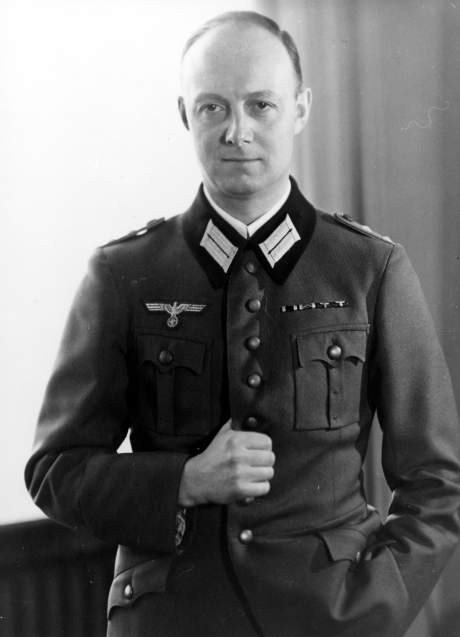
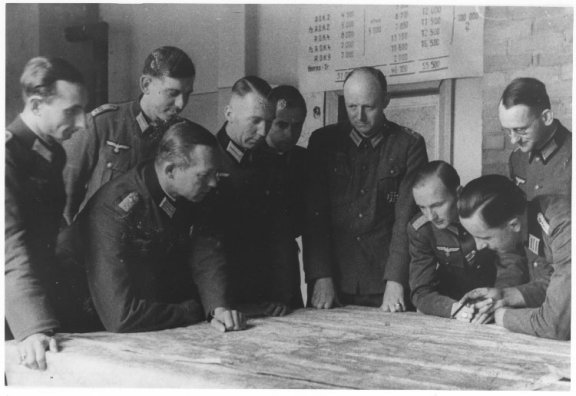 0
0 -
Based on Wiki - Andreas Hermes was an agricultural specialist who also served as a Christian Democrat minister and who resisted Nazism. Hermes was a native of Cologne. He studied agriculture and philosophy at the universities of Bonin, Jena and Berlin. After graduation, he taught agriculture and was an agricultural adviser to a livestock breeder. In 1906, he was awarded a doctorate by Jena University for a thesis on 'the optimisation of the rotation?. Before and during the First World War, he served in various scientific and advisory functions in the agricultural field.
In 1919 he was appointed to the Reich Ministry for Economic Affairs in Berlin. In 1920 he became Reich Minister for Food and Agriculture and from October 1921 to August 1923 he headed the Reich Ministry of Finance. From 1924 to 1928 he was a member of the Prussian parliament and from 1928 to 1933 he was also a member of parliament as a Centre Party representative. He was president of the Reich Association of German agricultural co-operatives from 1930 to 1933 and President of the Association of German Farmers' Associations, that was renamed the Christian Association of German Farmers' Associations in 1931.
He openly opposed the Nazis from 1933 and served four months in prison. In 1936 he went into exile in Colombia, returning to Germany at the outbreak of war in 1939. He developed close contacts with Goerdeler and the Kreisau Circle. Hermes was to have been the Minister of Agriculture in the post-coup transitional government had the July 20 bombing succeeded.
As a result of the Gestapo finding his name on the plotters? proposed cabinet list, he was arrested and sentenced to death by the People?s Court on 11 January 1945. Due to the efforts of wife his execution was postponed. He was one of the last of the prisoners released from the Lehrterstrasse prison and he narrowly avoided the summary SS executions of death row prisoners that took place there in the last few days of the war.
The letter below was written to executed resister Ulrich von Hassel in 1924.
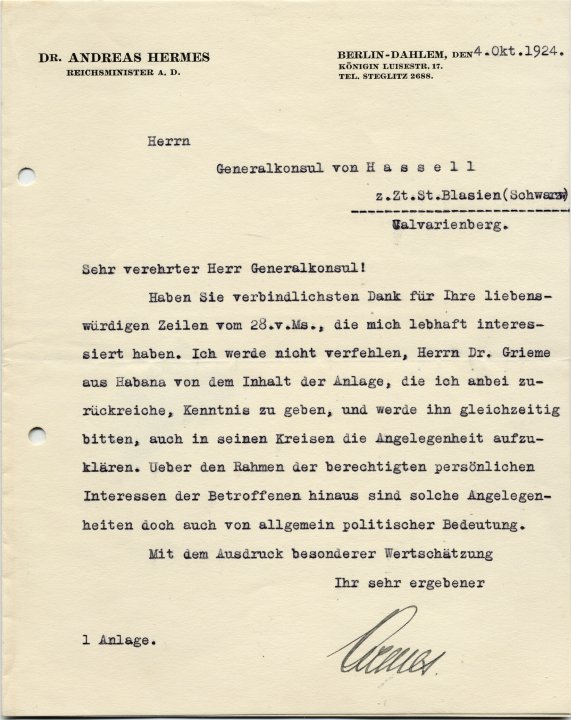
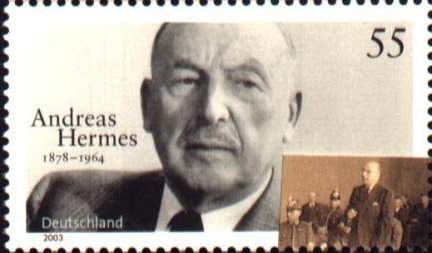 0
0 -
Thanks for the observations Patrick.
"The countless thousands of Germans who died in the war must surely have died for a new Germany, or else they died for nothing at all, there is no third possibility. This Germany does not yet exist, but it is coming, we are struggling to help it, and when we fight for Germany, we are fighting for a new Europe."
Theodor Haubach grew up in Darmstadt where he volunteered for the army in World War One. He was commissioned in the field and was wounded eight times. In 1919, he began the study of philosophy with his close friend and co-resister to be, Carlo Mierendorff. Both became socialist student leaders of the at the University of Heidelberg. Even in the twenties, Haubach bitterly opposed the Nationals' soon to be the National Socialists. He had a reputation for being icily calm and even remote in debate, while being fiery in political actions. His knowledge of philosophy and politics made for a strong intellectual combination.
In 1923, Haubach received his doctorate in philosophy and joined the Institute of Foreign Affairs in Hamburg. A year later, he became assistant editor of the Hamburg Echo where he worked in support of the Weimar Republic. In 1930 he joined the Prussian Ministry of the Interior as Press Officer and subsequently took the post of Press Officer at the Berlin police department.
Haubach, a known socialist, was arrested and rearrested over the early days of the Nazi regime. He spent two years in KZ Esterwegen. After his release, he worked as an insurance agent. After his third release form prison, Haubach's friend Victor Bausch, gave him a job in a paper factory.
In 1943, Haubach was approached by Helmuth James von Moltke's Kreisau Circle. He attended at least one of its landmark meetings with fellow socialists Mierendorff, Leuschner and Leber. When Mierendorff was killed by an Allied bomber in '43, it was Theo Haubach who composed an epitaph for the paper in the name of all his friends.
Haubach was arrested on August 9, 1944 by the Gestapo. In January 1945, he was sentenced to death by Freisler and executed. He left this quote, which could be considered an epitaph for the resistance movement:
"Now the limits of violence are that it may well destroy the person who resists, but not the force of resistance. Of course if it were actually possible to wipe out all the people who were inspired by the spirit of resistance against tyranny, the destruction would amount almost to the annihilation of the spirit itself; but what cannot be destroyed is the memory of the event, should such annihilation take place?"
It is noted that most of Haubach's philosophical papers were burnt or destroyed. Only a few letters survive him, of which the card below is one.
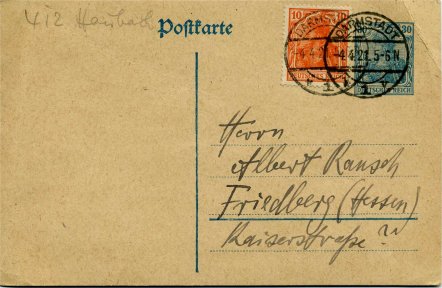
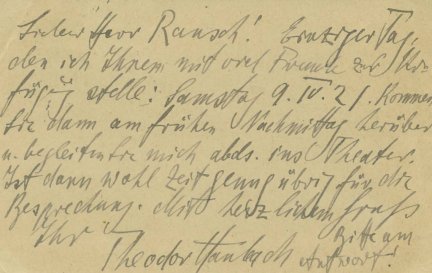
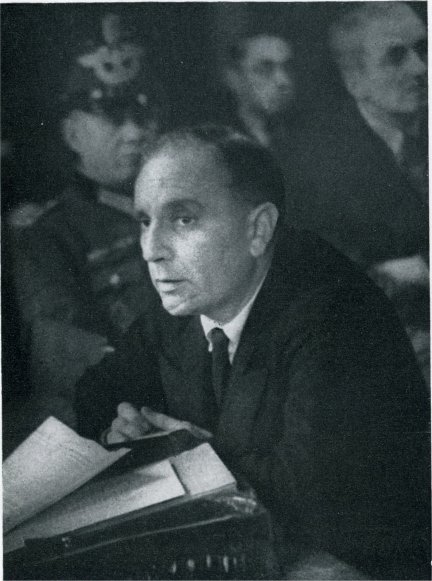 0
0 -
That would be Ben Wieder's magnificent Napoleonic collection which he donated to the Montreal museum. The institutions built a whole gallery for the collection. My wife and i will be heading up there for a view this spring. Wieder was a millionaire seller of excercise equipment and co-author of "The Murder of Napoleon" and "Assassination at St. Helena."
http://www.mmfa.qc.ca/en/expositions/exposition_134.html
Colin
0 -
Here's the AIHA's Gerard - its nicer than mine but I like mine anyway.
Colin
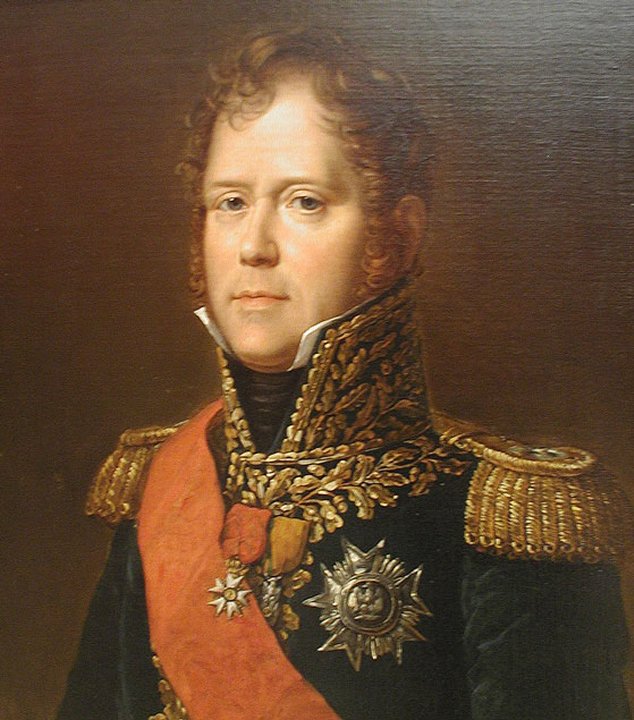 0
0 -
Here is a portrait of Michel Ney I purchased some years ago. Its unsigned but is attributed to Ezra Ames of Albany, New York. See http://en.wikipedia.org/wiki/Ezra_Ames for more on the artist.
Ames was the premier portrait painter in NY state in the late 18th and early 19th C. This portrait of Ney was based on the Gerard portrait owned by Citizen Genet. Its now in the Albany Institute of History and Art, with many of Ames' works - he was a founder of this museum.
This copy was most likely executed in the 1809-1812 period.
Colin
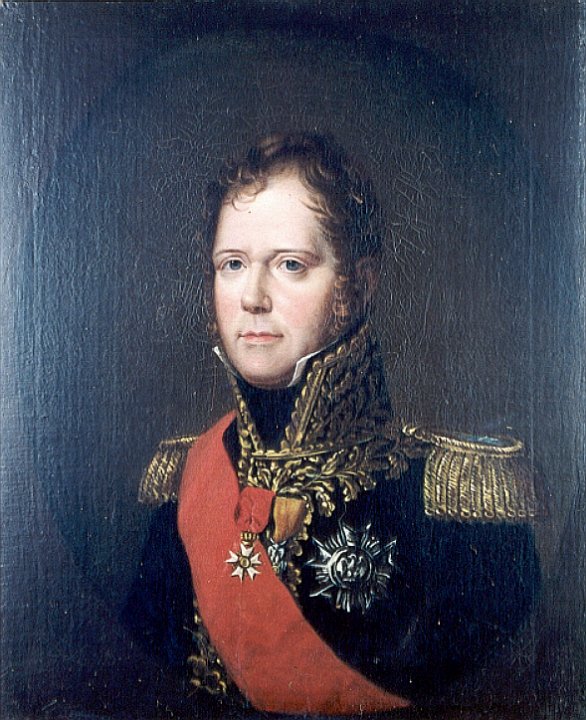 0
0 -
Here is the text of Napoleon's decree sent with this letter:
20/06/1805 D?cret sur l'organisation de la Garde royale
TITRE I : Dispositions g?n?rales
Article I : la Garde royale sera compos?e de :
1 corps de Gardes d'Honneur
1 corps de V?lites
1 corps de Garde de ligne.
TITRE II : Des Gardes d'Honneurs
Article 2 : il sera form? dans notre Royaume d'Italie, 4 compagnies de Gardes d'Honneur qui porteront les noms suivants :
- 1?re Cie de Milan
- 2?me Cie de Bologne
- 3?mc Cie de Brescia
- 4?me Cie de la Romagne
Article 3 : chaque compagnie sera compos?e de 100 hom?es dont 60 ? cheval et 40 ? pied.
Article 4 : ces compagnies seront form?es des fr?res,fils, pefit-fils, neveux et petit-neveux et cousins des membres des trois coll?ges et des jeunes gens de la conscription,fils ou neveux des plus impos?s des d?partements.
Article 5 : La compagnie de Milan sera compos?e des jeunes gens des d?partements de l'OLONA,de l'AGOGNA,du LARIO et de l'ADDA. La compagnie de Bologne sera compos?e des jeunes gens des d?partements du RENO, du CROSTOLO, du PANARO et du MINCIO. La compagnie de Brescia sera farm?e des jeunes gens des d?partements du SERIO, de l'ALTO PO, de la MELLA et de l'ADIGE. La conpagnie de la Romagne des jeunes gens des d?partements du RUBICONE et du BASSO PO.
Article 6 : Jusqu'? ce ces compagnies soient au complet,aucun fr?re,fils, petit-fils,neveu, petit-neveu ou cousin des membres des trois coll?ges ou fils ou neveu des plus impos?s des d?partements qui les uns ou les autres se trouveraient de la conscription ne seront admis ? se faire remplacer.
Article 7 : Ces compagnies feront le service aupr?s de la personne du Roi.
Article 8 : Deux ans de service dans ces compagnies donneront le grade de sous-lieutenant.
Article 9 : Tous ceux qui y seront admis devront avoir un revenu de 1200 livres de Milan ou de leurs biens propres ou en une pension assur?e par leurs parents, tous les trimestres ? la caisse de la compagnie et seront sold?s aux gardes tous les mois ? raison de 100 livres par mois.
Article 10 : Il sera fourni aux gardes ? cheval, un cheval harnach? et des rations pour la nourriture du cheval. Les hommes tant ? pied qu'? cheval recevront pour la nourriture et les v?tements un pr?t de 30 livres par mois. L'armement et les casernements seront fournis par les magasins royaux.
TITRE III : Des V?lites Royaux
Article 11 : Il sera form? 12 compagnies de Gardes V?lites composant 3 bataillons de 4 compagnies.
Article 12 : Les bataillons de V?lites royaux feront le service aupr?s de la personne du Roi; pendant la paix ils seront employ?s ? la garde des palais et pendant la guerre ? la d?fense de sa personne.
Article 13 : Chaque d?partement fournira une compagnie ? l'exception du CROSTOLO qui sera ? cet effet r?uni au PANARO et de l'ADDA qui sera reuni au LARIO.
Article 14 : Les compagnies de l'OLONA, de l'AGOGNA, du LARIO et de l'ALTO PO formeront le Premier Bataillon,les conpagnies du PANARO, du BASSO PO, du RENO et du RUBICONE le Deuxi?me Bataillon; les compagnies du SERIO, de la MELLA, de l'ADIGE et du MINCIO le Troisi?me Bataillon.
Article 15 : Chaque compgnie sera compos?e de 100 hommes dont 3 officiers, 4 sergents et 8 caporaux.
Article 16 : Les masses de boulangerie, d'habillemcnt, de chauffage et autres seront les m?mes que celles de la Garde royale de ligne ? pied. La solde sera de 10 sols de Milan par jour.
Article 17 : Les parents de chaque V?lite leur assureront annuellement une somme de 200 livres de Milan qui sera vers?e dans les caisse du corp. Cette somme sera distribu?e aux v?lites par portions de 5 jours en 5 jours en forme de suppl?ment de pr?t.
Article 18 : Le remplacement pour la conscription ne sera permis dnas les d?partements que lorsque les compagnies de V?lites de ces d?partements seront compl?tes.
Article 19 : Apr?s deux ans de service les V?lites royaux auront le rang de sergent, ils en porteront la distinction et pourront entrer dans
ce grade dans les troupes de la ligne.
TITRE VI : Des Gardes de la Ligne
Article 20 : Les Gardes de la Ligne seront compos?es de :
- un escadron de 4 compagnies de dragons. Chaque compagnie sera de 100 hommes dont 60 ? cheval et 40 ? pied. Le corps sera command? par un colonel.
- un r?giment d'infanterie de 2 bataillons, le premier de 5 compagnies de grenadiers et le deuxi?me de 5 compagnies de chasseurs. Chaque compagnie sera de 100 hommes.
- une compagnie d'artillerie l?g?re. Cette compagnie sera de 64 hommes.
Les Gardes de la ligne n'auront qu'un seul Conseil d'administration.
Article 21 : Tous les individus existants dans la Garde royale actuelle y conserveront leur grade et leur droit.
Article 22 : Le corps de la Garde de la ligne sera d?sormais recrut? parmi les hommes des corps de la Ligne qui auront 5 ans de service et qui se seront distingu?s par leur tenue, leur conduite et leur bravoure
Article 23 : Exc?cution...
29/06/1805 D?cret sur les uniformes de la Garde Royale d'Italie
Art 1 : Gardes d'honneur
- Milan : habit ? la fran?aise rouge ? revers, col, parements et retroussis gros bleu.
Boutonni?res en argent. Aiguilettes et tr?fles en argent.
Culotte et veste blanches.
Sabre de dragon et bottes ? la cavali?re.
Chapeau bord? en argent.
Mousqueton et giberne ? fourniment en galon argent.
Selle de veau laqu? blanc, housse et chaperons gros bleu ? galon argent.
- Brescia : bleu ? distinctive cramoisie. Housse et chaperons cramoisis et galon argent.
- Bologne : blanc ? distinctive gros bleu. Housse et chaperons gros bleu ? galon argent.
- Romagnes : vert ? distinctive ?carlate. Housse et chaperons ?carlates ? galon argent.
Art 2 : V?lites royaux
Habit blanc avec col et revers verts. Epaulettes rouges. Bonnet de grenadiers.
Fourniment complet.
Culotte et veste blanches.
Gu?tres noires.
0 -
Erich Kordt, like his brother Theo, was a foreign service officer in the German government. Like his compatriot Adam von Trott zu Solz, he spoke fluent English and was educated partially at Oxford, the recipient of a Rhodes Scholarship. Kordt joined the Foreign Office in 1928 and was initially posted to Switzerland. He then served as Legationsrat or counsellor in the London Embassy under Ambassador von Ribbentrop, for he had personal and professional contempt. He joined the Nazi Party in 1937 as this was de rigeur for any foreign service officer hoping to keep his job. In February 1938, once Ribbentrop became Foreign Minister, Kordt was appointed head of the Foreign Office's "Ministerial Bureau".
Both Kordt brothers were heavily involved in the so-called Oster conspiracy in 1938. This was the first and probably the most likely to succeed coup pan developed by the resisters. Kordt was involved in two ways ? firstly he volunteered to assassinate Hitler with a bomb as he had personal access to the Chancellery. However, at this pre-war stage, explosives and silent fuses were not easily procured, even by senior officers in the Abwehr, and Kordt's offer could not be acted upon.
Instead, Oster organised a planned arrest of Hitler should he trigger a war with Czechoslovakia and Britain/France of the Sudetenland. As Beck said at the time, "Bring me certain proof that England will fight if Czechoslovakia is attacked, and I will put an end to this regime." All they needed was a firm stand by the British government, as occurred in 1939 over Poland. The plan was for Erich Kordt to open the doors to the Chancellery to a commando team located in apartments across the road. This team was commanded by Werner Schrader's friend, Friedrich Wilhelm Heinz, later a commander of a Brandenburger battalion. Oster and Heinz developed a secret plan within the overall plan to shoot Hitler during his arrest, as they were the only ones who realised that Hitler's death was a necessary pre-condition to a successful putsch. Kordt visited the Chancellery often over several days at all hours to ensure that the guards were used to his presence and to put them at ease. Unfortunately the whole plan came to naught when Chamberlain flew to Munich to appease Hitler.
Theodor Kordt, who acted as Charge d'Affaires at the London embassy, was considered a vital contact with the British on whom the success of the plot depended. The conspirators needed strong British opposition to Hitler's seizure of the Sudetenland. Erich used his brother as an envoy to urge the British government to stand up to Hitler over the crisis, in the hope that Army officers would stage a coup against Hitler.
In June 1939, Kordt went to London to warn Robert Vansittart, the diplomatic advisor to the British government, of the secret negotiations between Germany and the USSR which were to lead to the Nazi-Soviet non-aggression pact. He was dismayed that all approaches made by the German resistance movement within the German Foreign Office were ignored by the British, a pattern that was repeated throughout the pre-war and following periods.
In April 1941, Kordt was posted to Tokyo as German embassy First Secretary and later to Nanking as German Consul, where he worked as an agent for the Soviet spy Richard Sorge until 1944. He narrowly avoided being killed by a Japanese assassin when Japanese Intelligence discovered that his espionage activities.
In June 1948, at the Nuremburg war crimes trials, Kordt testified on behalf of Ernst von Weizsaecker, who was being tried for his and the Foreign Office's role in facilitating Hitler's aggressive foreign policy. Despite clear evidence of Weizsaecker's key role in trying to depose Hitler and stop the war before it started, he was convicted. No British foeign service officer would confirm his testimony for fear of embarrassing the British government by making it clear that the war could have been avoided. Partly as a result of his testimony in support of Weizsaecker, Kordt aroused the hostility of Federal Chancellor Adenauer, who blocked Kordt's return to a career at the Foreign Office. From 1951, Kordt was a professor of international law at the University of Cologne.
The page below is a signed book dedication by Erich Kordt.
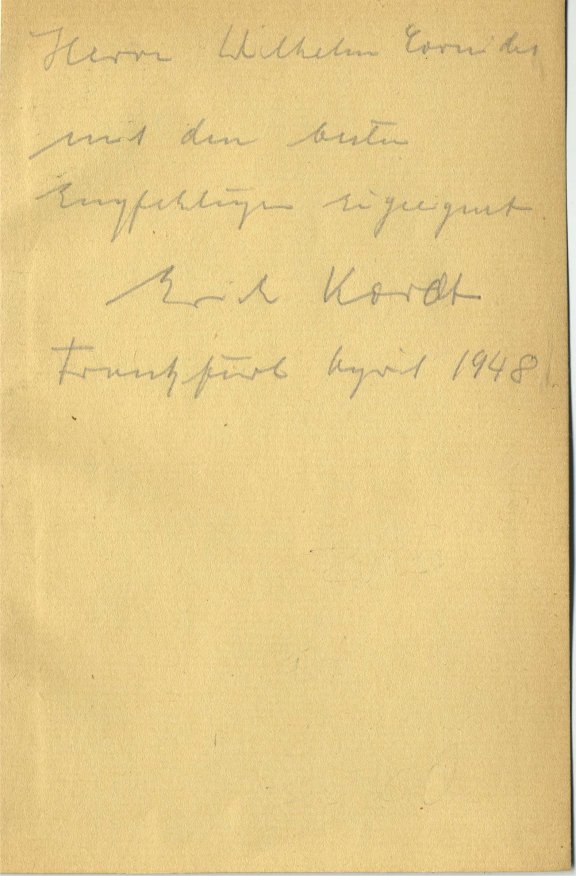
 0
0 -
Cat salute? BDOS? I hope those are good things.

Alexander Ernst Alfred Hermann Freiherr von Falkenhausen was the German general who served as Governor of Belgium and Northern France during the occupation by German troops. Coincidentally, he was related Ludwig von Falkenhausen, who served as Governor General of occupied Belgium in 1917-18.
Falkenhausen was commissioned as a second lieutenant in the German Army in 1897 and served as a military attache in Japan prior to the First World War. He was awarded the Pour le Merite or "Blue Max" during the war while serving on secondment with the Turks in the Middle East. After the war he stayed in service and later headed the Dresden Infantry School in 1927. In 1930 he retired from service and went to China to serve as Chiang Kai-Shek's military advisor. When Japan joined the Axis in 1937, Falkenhausen was recalled to Germany as it was no longer politically expedient to have him advising an enemy of his own country. Chiang declined to grant permission for von Falkenhausen's exit as he was custodian of the complete suite of China's strategic secrets. When informed of this, Foreign Minister von Ribbentrop threatened to have von Falkenhausen's family incarcerated in a concentration camp. When informed of this, Chiang gallantly gave von Falkenhausen permission to leave, asking only for his word of honour that no secret information would be disclosed. Upon his return, von Falkenhausen just as gallantly refused to provide any information to his own government or military, despite being strongly pressed to do so.
Von Falkenhausen was recalled to active duty in 1938. He served as an infantry general on the Western Front until his appointment as military governor for Belgium in May 1940. While serving as military governor his administration published 17 decrees against the Jewish population of Belgium as preparatory measures leading in June 1942 to the Final Solution and the deportation of 28,900 Jews. His deputy for economic affairs, Eggert Reeder was responsible for the destruction of "Jewish influence" in the Belgian economy, leading to mass unemployment of Jewish workers, especially in the diamond business. Some 2,250 of these unemployed were thus sent to forced labour camps in Northern France in order to build the Atlantic Wall for the Todt Organisation. Some 43,000 non-Jewish Belgians were also deported to German camps of which 13,000 died. In addition, hundreds of resistance fighters were shot by the German army during the occupation.
He was a close friend of anti-Hitler conspirators Carl Goerdeler and Erwin von Witzleben and like them he came to loathe the Hitler administration. He offered support to von Witzleben for a planned coup d'etat in 1938 and 1939. Early in the war, he tried to lure Hitler into visiting his headquarters where he had the intent of arresting him. Hitler was wise enough to decline all such invitations.
After the failure of the July plot, von Falkenhausen was arrested and he spent the rest of the war transferred from one concentration camp to another. His name was found amongst the files in the Dohnanyi archive discovered in Zossen following Oberstleutnant Schrader's suicide. He probably would have been executed except for the late April 1945 date of discovery and the extent of disorganisation in the Reich at that date. Von Falkenhausen was part of a column of 140 high value prisoners including the families of many of the executed resisters and others such as Generaloberst Halder, Leutnant Fabian von Schlabrendorff, and arrested British agents Stephens and Best of Venlo fame. Scheduled for immediate execution by their SS guard if liberation looked likely, the hostages were liberated by Wehrmacht soldiers and turned over to American forces. Von Falkenhausen was instrumental in making contact with the commander of the German troops.
After his liberation, von Falkenhausen was sent to Belgium for trial in 1948, and in March 1951 he was sentenced to 12 years hard labour for deporting 25,000 Jews and executing Belgian hostages. However, he was acquitted and released three weeks into his sentence after overwhelming evidence proved that he had tried to save as many Jews and Belgians as possible from deportation and execution.
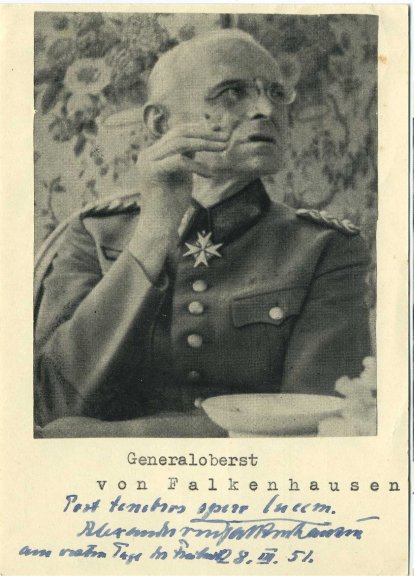
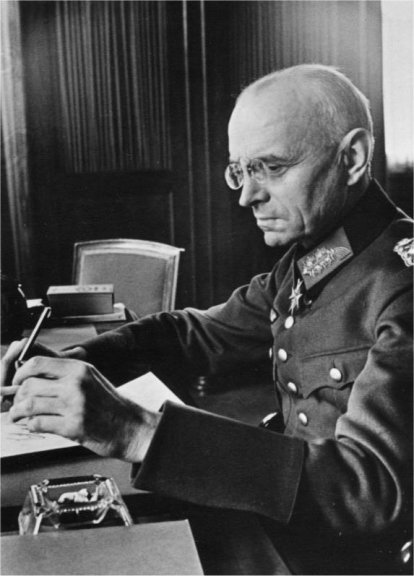 0
0 -
Guenther Blumentritt was a Bavarian, born in Munich in 1897. He joined the German Army and during the First World War he served on the Eastern Front. Blumentritt was a close friend of Erich von Manstein. He served as a staff officer in the invasions of Poland in 1939 and France in 1940. In 1941, he served in the Russian Campaign before returning to Germany to serve as Chief of Operations. He strenuously opposed the invasion of Russia, noting unavoidable parallels between the German plan and that of Napoleon in 1812. He tended to concur with Hitler's blindly applied no retreat policy, again citing the fate of Napoleon's army during its collapse in 1812.
There is controversy surrounding the extent of Blumentritt's involvement in the July plot. David Irving, whose interpretations are now discredited, but who was no slouch at uncovering rare documents, heavily implied that Blumentritt was in the know prior to the bomb attack on Hitler. At the time of the Stauffenberg bomb attack, Blumentritt was Chief of Staff for von Rundstedt in his capacity as Commander in Chief West. In his post-war "other side of the hill" interviews with Basil Liddell-Hart, Blumentritt admitted that Hans Speidel had drawn him aside in March 1944 and, speaking for Rommel said: "The time has come when we must tell the Fuehrer that we cannot continue the war." With the agreement of von Rundstedt, a telegram was sent to Hitler to this effect - no reply was received. Subsequently, Speidel informed Blumentritt that there were men in Germany who were preparing to depose Hitler. He specifically identified von Witzleben, Hoepner, Goerdeler and Beck. Blumentritt later asserted that Speidel did not raise the spectre of assassination although this must be considered disingenuous as a man as smart as Blumentritt must have known that there was no prospect of a successful coup while Hitler lived.
The famous telegram sent by von Rundstedt, followed by his "make peace you fools" phone call with Keitel, provided the impetus for Rundstedt's removal and replacement by Guenther Hans von Kluge. Blumentritt remained in his role as von Kluge?s Chief of Staff. On July 20, Blumentritt was front and centre as von Kluge initially welcomed news of Hitler's assassination and prepared to halt V-1 attacks on England and open negotiations with the Allies. Later, as mixed news emerged, he advised von Kluge to call Wolfschanze where no one could be found to confirm or deny Hitler;s death. In the end, it was Blumentritt who correctly interpreted the circumstantial evidence to mean that there had been an unsuccessful attempt on the Fuehrer. After von Kluge made his decision to detach himself from the plotters, Blumentritt advised him to send Hitler a message of congratulations on his survival. He also was instrumental in concert with Ambassador Abetz, in brokering the mutually agreed fiction adhered to by Heer and SS officer alike that the arrests on July 20 had been an exercise. This had the effect of limiting the Gestapo's victims in Paris to less than a dozen officers.
Blumentritt was called to attend on Hitler and he fully expected to be arrested and perhaps executed given the fates that had befallen other senior commanders in France. Instead, Hitler conferred the Knight's Cross on him and ironically put him in command of an SS Corps. Blumentritt survived the war with his military and personal reputation largely intact.
The letter below is the transmittal cover for the signed picture. The group shot includes (from the left) Blumentritt, Speidel, Rommel and von Rundstedt at the latter's HQ Roche Guyon Paris.
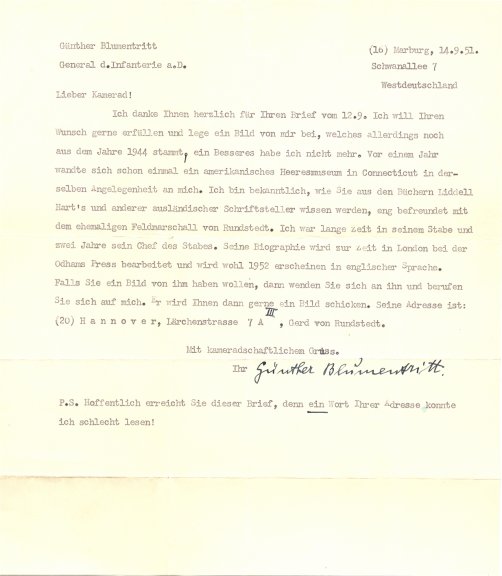
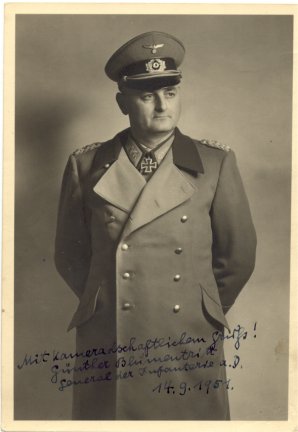
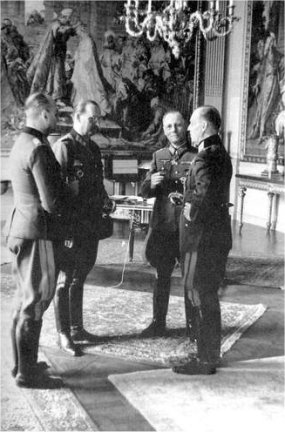 0
0 -
Generalleutnant Hans Speidel was, like Rommel and Stauffenberg, a Swabian from the Wurtemburg area. He represented one of the younger and more energetic members of the resistance. He is sometimes presented as having come to the side of the conspirators only after experiencing two years of brutal and total war on the eastern front but it should be remembered that Speidel served as an aid to Beck for diplomatic assignments in the pre-war period and he was almost certainly influenced by him.
Speidel served in the First World War and he stayed with the Reichswehr in the inter-war period becoming a General Staff officer and reaching the rank of Lieutenant-Colonel by 1939. He served in the French campaign as Chief of Staff to the military commander in France and in 1942 he was transferred East, becoming Chief of Staff to V Corps. By 1943, he was Chief of Staff to Army Group South and a Generalmajor. In 1943, Speidel was Chief of Staff to General Hubert Lanz. In this role, he conspired with Lanz and one of his Corps commanders, Hyazinth von Strachwitz, to kidnap and, if necessary, kill Hitler during an expected front visit at Poltava on February 17. The plan failed when Lanz retreated in violation of "stand fast" orders and was relieved.
In April 1944, Rommel asked for him and Speidel was transferred west to become Chief of Staff to Army Group B, the primary defensive force for the coming Normandy invasion. In this position, Speidel did much to influence Rommel to join, or least not impeded the conspirators in their efforts to unseat Hitler. There is talk, mostly based on sloppy history by David Irving, that Speidel deliberately sabotaged German operational efforts to respond to the Normandy invasion by withholding panzer reserves that could have been committed. However, this has been discounted by Rommel's naval aid von Ruge: "There does not exist any proof, and betrayal certainly was not in Speidel's nature."
After Rommel's wounding in a strafing attack on July 17, 1944, Speidel continued in his role as Chief of Staff to Army Group B, now serving Generalfeldmarschall Hans von Kluge who was performing the dual roles of Commander of Army Group B and Command in Chief West. He was unaware of the pending July 20 attack even though he was engaged as a full member of the conspiracy. Given that just two full days had passed between von Kluge's assumption of command and the bomb attack on Hitler, Speidel had no opportunity to brief von Kluge on the conspirators? plans, despite the fact that he was known to be generally supportive of removing Hitler. During July 20 in Paris, Speidel had little opportunity to influence events as they played out very quickly between late afternoon when orders were given by von Stuelpnagel to arrest all SS and Gestapo personnel. Later in the evening, it became apparent that Hitler had survived and was still in control.
After the collapse in Paris, very few officers were arrested compared to Berlin. Despite clear evidence of a pervasive resistance effort. This could have been due to a reluctance to disrupt the command structure on a critical front but was more likely due to a sham cover story agreed to between the army and SS to explain the reasons for the arrests.
Speidel was not spared however. He was arrested by the Gestapo and interrogated. David Irving says that he implicated Rommel under torture but Speidel's close post-war friendship with the Rommel family belies this accusation.
It is clear that Hitler believed Speidel guilty. However, he was one of the few, if not the only one, who was considered for expulsion from the Wehrmacht by the army court of honour chaired by von Rundstedt and who was not expelled. It is thought that Speidel's close contacts with senior officers like Guderian protected him. Expulsion from the Wehrmacht was a necessary pre-condition for trial before the Peoples' Court so Speidel was effectively protected from both the security service and Hitler's judiciary. Nevertheless Speidel was jailed by the Gestapo. At the end of the war he escaped and was saved by French troops.
After the war, Speidel was involved in the creation of the Bundeswehr, rising to full general and Commander in Chief of all Nato ground forces in Europe.
The signed (on rear) portrait photo below is a rarely seen one of Speidel in his Heer uniform. The other photo is a pre-war shot of Speidel (left) with Beck on a diplomatic assignment.
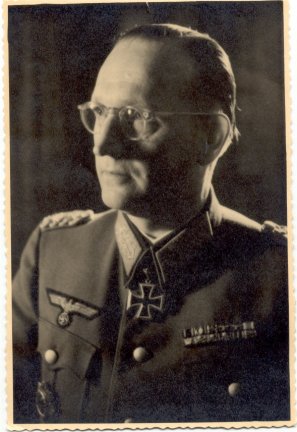
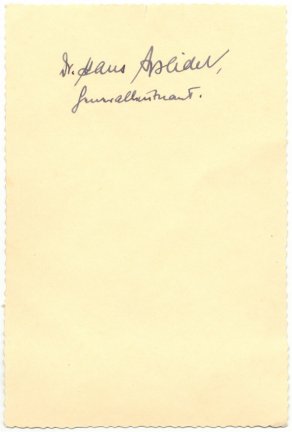
 0
0 -
Karl Stroelin was Lord Mayor of the Swabian city of Stuttgart. Like Carl Goerdeler, he was a conservative politician who was an initial admirer of the demonstrated strength and national priorities of the Nazis. Only when Nazi crimes became apparent did he begin to lose faith in Hitler and move into the opposition camp.
He was the son of a career officer and he fought in the First World War. He left the army as a direct result of the downsizing that resulted form the Versailles Treaty. He earned a doctorate with a thesis on the situation of the workers and middle class after the war. He was drawn into the sphere of the Nazi party in the 1920's and joined it in 1931. In 1931, Stroelin ran for election as Lord Mayor of Stuttgart as the Nazi candidate, he was decisively defeated. Instead, he ran for and succeeded in winning a position on the city council. After the rise of Hitler in 1933, Stroelin became Lord Mayor. His main administrative duties as Mayor focused on urban planning and housing matters.
Stroelin was also the chairman of the German Foreign Institute, effectively mayor of the notional administrative city that incorporated all overseas Germans. He was chosen for this role as a result of the fact that many emigrants form Germany were Swabians. After the war, he was accused of encouraging and administering German international intelligence and fifth column activities. It was established at Nuremburg that he intervened with Nazi authorities, including Freisler, to save several people from death sentences.
Stroelin was a close friend of Rommel. In the film "The Desert Fox," he was portrayed by Cedric Hardwick who quite accurately applies influence on the Swabian Field Marshal to revolt against Hitler. It is thought that Stroelin's influence was key in getting Rommel to turn against Hitler, even in the limited way he did so. After the July 20 bomb attack, Stroelin's house was searched by the Gestapo but nothing incriminating against him was found. Nevertheless, he was still suspected given his contacts with Goerdeler and Rommel and he lost his party rank.
As French and American troops advanced on Stuttgart in April 1945, the Nazis declared the city to be a fortress and called for its defenders to fight to the last. As a former officer Stroelin knew that the city could not be defended. The city had already been significantly damaged by air attack and a ground assault could only lead to the loss of remaining buildings and inhabitants. Stroelin risked his life and reputation and made the bold move to secretly contact the French army and he offered the peaceful surrender of his city. The Gestapo learned of his contact with the Allies and obtained an arrest warrant against him. However, transmission of the arrest order was sabotaged and he was not arrested in the waning days of the war.
Stroelin as a Lord Mayor of a major German city and senior Nazi leader was initially seen as a major Nazi offender. When the Allies came to understand his involvement with the July plot and resistance, he was released on bail and quickly processed through the denazification courts. He was a witness at the Nuremburg war crimes trials, primarily in support of von Neurath. After the war, Stroelin was shunned by the left and the right given his Nazi past and as a result of his surrender of Stuttgart.
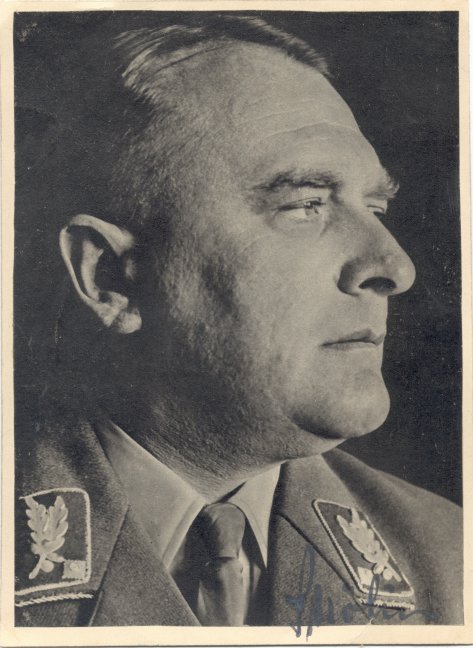
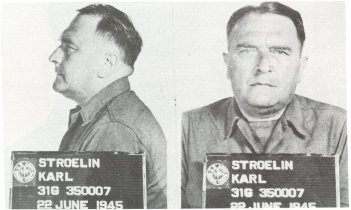 0
0 -
wonderful!!!!
Did you see Puttkamers' photos of July 21/22/23 for sale recently?
I did! And they would be majic to own but I'm not sure of the market value in these tough times. While their provenance would make them a treasure for me, unfortunately the peaks of cash available for collecting do not always coincide with the availability of nice items! Thanks for the heads up!
Colin
0 -
1938 pencil postcard from Erwin Rommel to his wife Lucie:
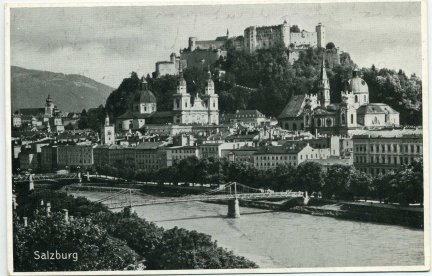
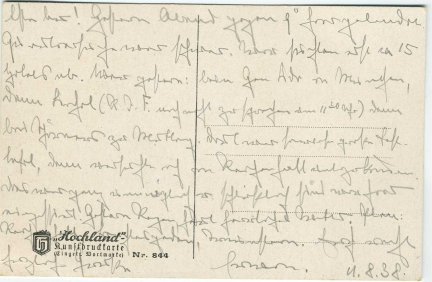 0
0 -
January 4, 1941
Dear Hausser!
Many thanks for your kind letter dated December 28 and your good wishes for 1941 which I heartily reciprocate.
Your son is a strapping mountaineer. I enjoyed your pictures very much.
To the sorrow of my family I spent Christmas out here very quietly. Albeit, that cannot be helped.
The story about the flares against tanks in the "Ghost Division" is, of course, incorrect. Otherwise the book is well written.
With best wishes from our house to your house.
Yours,
E. Rommel
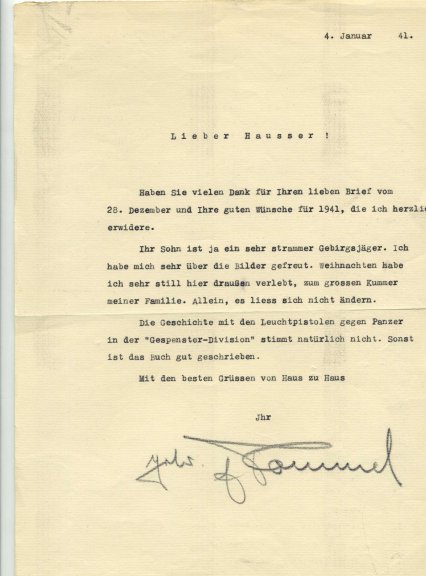 0
0 -
Rommel, recently promoted Generalmajor, and now Commandant of Hitler's mobile headquarters and commander of the Fuehrer's escort battalion, writes a post card in ink to his wife Lucie in Wiener Neustadt. The card was mailed from Kreuzberg in East Prussia and is dated September 9, 1939, only six days into World War II.
Dearest Lu!
We are now in the North. In the Northern edition of the Voelkische Beobachter you can see your general next to the Fuehrer at the Vistula River in Graudenz. Things are going amazingly well for me. Almost interesting news.
If we manage to maintain this pace, the war will be over in the West by the end of October, in my opinion. It was well managed you will probably say.
What is Manfred doing? How do they see things at the Castle?
Right hearty greetings,
Your Erwin.
September 9, 1939

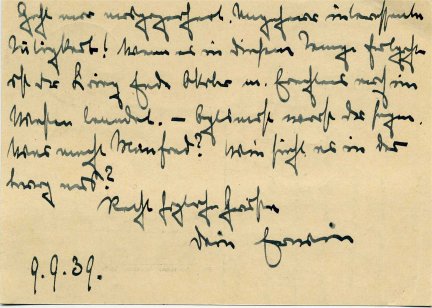 0
0 -
Erwin Rommel, Germany's "Desert Fox," is probably the best known of Hitler's commanders. Despite serving a criminal regime, he managed to gain and retain the respect of both his countrymen and his enemies. Rommel is credited with doing his best to fight a chivalrous war, even under "total war" conditions. For example, he was one of the few commanders who refused to implement Hitler's infamous "Commando Order" that required the execution of all captured commandos and saboteurs, whether taken in uniform or not.
A professional soldier, Rommel served in the elite Alpine Corps during the Great War. He was wounded three times, earned the Iron Cross (first and second class) and was awarded Prussia's highest decoration for valour, the Pour Le Merite or "Blue Max." Between the wars, he was an instructor at the Dresden Infantry School from 1929 to 1933 and at the Potsdam War Academy from 1935 to 1938. In 1937, he published his lecture notes, base don his war diaries, as a much-read manual entitled "Infanterie Greift An" (Infantry Attacks). In 1938, Rommel, now an Oberst, was appointed to command Hitler's personal protection battalion, the Fuehrer Begleitbattalion. Promoted to Generalmajor in 1939, he commanded the Fuehrer's mobile headquarters throughout the Polish campaign.
In 1940, Rommel was given command of 7. Panzer Division, later nicknamed the Gespenster-Division (Ghost Division). Remarkably, this was Rommel's first command of a panzer unit. As a reward for outstanding performance in France, Rommel was given command of the German mobile troops that were being sent to North Africa to assist the defeated and dispirited Italians. It was in command of this "Deutches Afrika Korps" that Rommel would achieve his greatest notoriety in the fluid battles fought across the North African desert in 1942. He became the darling of the Nazi press and even Churchill saluted his skills in parliament. In 1943, he was invalided home from Africa, before the inevitable surrender of German forces.
After his return from Africa, Rommel was unemployed for a period, although he did command the German forces entering Italy after that country's surrender and withdrawal from the Axis. Rommel did his best to shore up the beach defences of the "Atlantic Wall" after being placed in command of Heeresgruppe B and made responsible for defending the French coast against the expected Allied invasion. He sought Hitler's permission for his preferred strategy for deploying Germany's mobile reserves close to the likely invasion beaches. Hitler chose instead to keep his tanks in deep reserve until they could be used en masse after Allied intentions became crystal clear. History shows that Rommel's strategy would have served Germany better. The Allies gained a foothold in Normandy and for that point, Rommel judged that the war in the west was lost.
Several members of Rommel's staff were heavily involved in the anti-Hitler conspiracy within the Wehrmacht including his Chief of Staff Hans Speidel, his chief naval aid Friedrich Ruge, and his personal aid Hellmuth Lang. In addition, other high ranking officers serving in the West were involved, particularly General von Stuelpnagel, the Military Governor of occupied France. During Rommel's command in France, several attempts were made to recruit him as an active resister. On several occasions, the conspirators directly approached him. Dr. Karl Stroelin, the Oberbuergermeister of Stuttgart lectured Rommel and appealed to his conscience on multiple occasions. Hans Speidel arranged for Stuelpnagel's adjutant and cousin, Caesar von Hofacker to approach Rommel and seek his approval to assist the plotters by surrendering in the West. On July 11, 1944, Hofacker returned to Berlin to brief Stauffenberg and Goerdeler, thinking Rommel was solidly behind the conspiracy. Lucie Rommel has always maintained that her husband would not have approved of an assassination plot and that he only wanted Hitler deposed, arrested and tried as a criminal.
On July 15, 1944, the same day that Stauffenberg made his first abortive attempt to kill Hitler at Wolfschanze, Rommel wrote to Hitler informing him that it was his opinion that the war was lost and imploring him to make peace. The letter was sent in early August by his successor Hans Guenther von Kluge after Rommel was seriously wounded on July 17, 1944 when his staff car was strafed, most likely by an RCAF spitfire flown by Flt Lt. Charlie Fox, DFC. The Generalfeldmarschall was returning from a briefing session with Sepp Dietrich, the commander of the 1. SS Panzer Korps.
In August, Rommel was well enough to return home to recuperate. From then on things started to go steadily downhill for him as various bomb plot conspirators were tortured and interrogated by the July 20 Special Commission. In October 1944, Rommel was invited to attend upon Hitler at his headquarters to discuss future employment, but he was not well enough to travel. Instead, Generals Burgdorff and Maisel were dispatched to meet with Rommel at his home. They brought with them the shocking news that Rommel had been implicated in the plot, ostensibly by von Hofacker and Speidel. Inclusion of his name on the conspirators' list of prospective members of a post-coup government did not assist his case. It is also possible that von Stuelpnagel mentioned Rommel's name after his suicide attempt while delirious.
Rommel was presented with the choice of honourably killing himself of facing the People's Court under Freisler. He realised that he would never reach Berlin alive if he selected the second option as his name was too important to public opinion to allow it to be publicly listed among the conspirators. He would clearly become the victim of a staged SS accident if he tried to get to Berlin and his family would suffer accordingly. On October 14, 1944, Rommel said goodbye to his family and personal staff and drove off with Burgdorff and Maisel. He took cyanide after the staff car stopped on a country lane not far form his home. He was given a state funeral with full honours and it was not until after the war that the truth of his fate and the nature of his involvement with the Stauffenberg plot became known in Germany and in the West.
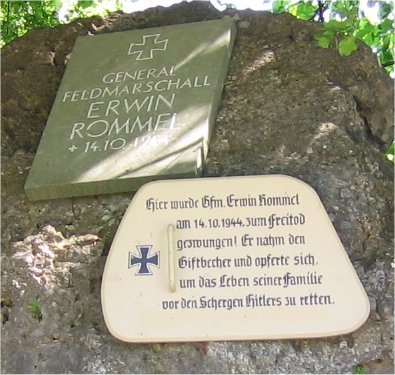
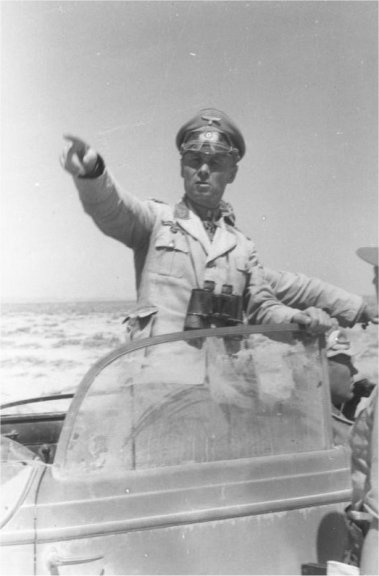
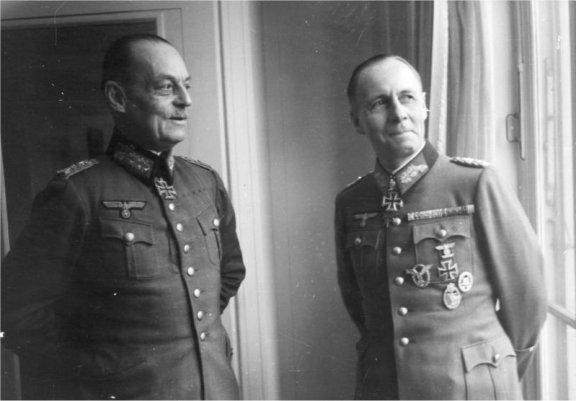 0
0 -
Very creative presentation. Are you concerned about acid damage? I may have missed it but this doesn't look like acid free paper.
My wife's best friend is a papers conservator by profession so I get lectured constantly about not touching my autographs bare handed and making sure they are mounted acid free.
Again - great idea.
Colin
0



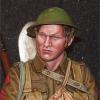
Napoleonic Art
in France
Posted · Edited by ColinRF
Hi Barry - standard portrait size c. 2.5' X 3'
Colin